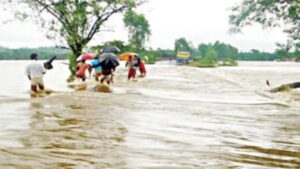Prothom Alo 13 July 2020

Floods are raging in 14 northern districts of the country. About 300,000 people are already stranded and about 1.4 million are affected. Those whose homes have been submerged, have had to take shelter on raised areas, especially under the open sky on the embankments.
On Thursday afternoon, about 3,500 families were in the open on the embankment in the flood-hit area of Sariakandi in Bogura. Many people have to stay on the embankment even after the flood waters have started receding in the neighboring Gaibandha district. The picture is the same in other flood-hit districts. Government shelters for flood-stricken people are so inadequate that most of the people have to stay in the open.
The main reason for this is the negligence of the government at the policy-making level regarding the flood victims. The authorities do not pay any heed to where thousands of families will seek shelter if their homes are washed away by the floods.
There are 4,200 cyclone shelters for 30 million coastal people in the country, while only 153 shelters are being built for 50 million people in flood-prone areas in the northern region. These 153 shelters cannot not accommodate more than 100,000 people.
This indicates the government considers cyclones more important than floods. Under a project for flood victims, an initiative has been taken to build 423 flood shelters at a cost of Tk 15 billion, which will be used as educational institutions after floods. But the surprising fact is that the 153 shelters, that are under construction, are mostly being constructed at the less flood prone areas. Fewer shelters are being built in areas where risk of floods are high.
What is the cause of this? Prothom Alo has learned from multiple sources in the Ministry of Relief and Disaster Management that a large number of flood shelters are being set up in the areas where the influential officials of the ministry are staying, such an area is Chandpur district. There have been 32 shelters built in there as it is the hometown of a former minister and a secretary.
Thousands of flood-affected families, with their children, burn in the sun under the open sky, soak in the rain, while ministry officials and influential leaders of the ruling party serve their political purposes with people’s money.
However, only 4 shelters are being constructed in the most flood prone districts of the country, Rangpur, 5 in Rajbari, 8 in Gaibandha, 9 in Lalmonirhat and 12 in Kurigram. In these districts too, many shelters have been set up near the homes of powerful and influential people.
Among the less flood prone districts, 26 shelters are under construction in Kishoreganj, 25 in Cumilla, 25 in Sunamganj, 23 in Sylhet and 20 in Netrokona. The poverty rate in these districts is also lower than in the more flood prone areas in the northern districts.
This inequality in the construction of flood shelters roots in unscrupulous decision making. It is entirely political, where welfare of the people is overridden by personal and party interests.
Such misuse of state funds in an attempt to attract votes cannot be tolerated in any way. Not only that, there are allegations of massive corruption in the construction of such installations, although this corruption is not investigated and no legal remedy is taken.
Thousands of flood-affected families, with their children, burn in the sun under the open sky, soak in the rain, while ministry officials and influential leaders of the ruling party serve their political purposes with people’s money. This must be stopped. It is imperative to investigate the flood shelter project and take appropriate legal action against those who are guilty.









